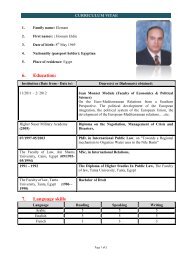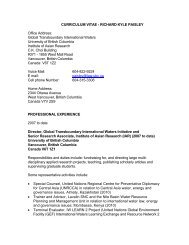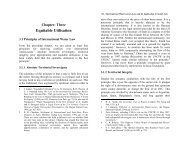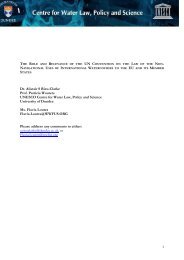Upreti, Trilochan, International Watercourses Law and Its Application ...
Upreti, Trilochan, International Watercourses Law and Its Application ...
Upreti, Trilochan, International Watercourses Law and Its Application ...
You also want an ePaper? Increase the reach of your titles
YUMPU automatically turns print PDFs into web optimized ePapers that Google loves.
Equitable Utilisation / 113 114 / <strong>International</strong> <strong>Watercourses</strong> <strong>Law</strong> <strong>and</strong> <strong>Its</strong> <strong>Application</strong> in South Asiacontinental shelf, allocation of marine resources <strong>and</strong> IWCissues. However, the political use of equity <strong>and</strong> the use ofequitable utilisation in legal spheres are different. The politicaluse of these words is always contentious <strong>and</strong> disputed, whilstthe legal sphere recognises it as a customary rule ofinternational law. For example, the use of equity in South-North relations, particularly in respect of internationalcooperation, entails providing resources <strong>and</strong> technologies, anissue that is always challenged by the North. 26 The politicalconcept of equity has been used to get unconditional financialresources from the North, whilst the legal use of equity is theapplication of the Articles 5 <strong>and</strong> 6 of the UNCIW <strong>and</strong> theprinciple enunciated by the ICJ in numerous cases as evaluatedin this research. The legal concept of equity is well defined <strong>and</strong>sufficiently certain for implementation. With regard to thepolitical concept of equity, the North has always maintainedthat it is not legally or even morally bound to help the South,whilst the South has taken the reverse position on these issues.Hence it is fair to say that the political concept of equity isvague <strong>and</strong> limited, perhaps to the point of being a slogan, <strong>and</strong>without compromise between two groups is not achievable. Toillustrate this point, CERDS <strong>and</strong> NIEO are always disputed.Thus the political use of equity remained a disputed whilst itslegal use has been unanimously recognised by both camps.After the prolonged <strong>and</strong> sustained effort of the ILA in itsHelsinki Resolution 1966, the rules of equitable utilisation asdeterminants of the allocation <strong>and</strong> sharing of water resourcesamong the riparian countries were adopted, which has becomethe substantive law ever since. 27 However, they are an earlydevelopment made by non-governmental organisations. At thesame time, it should be borne in mind that the outcome of therules is the result of largely accepted state practices, scholarlywriting <strong>and</strong> case law. That is to say, it is a reflection of theexisting customary rules of international law. 28There is a set of rules that provide for the rights, duties <strong>and</strong>responsibilities of watercourse states in matters relating to thesharing of resources. The basic rule is contained within ArticleIV of the Helsinki rules. 29 The formulation of those rules wasundertaken as a collection of general principles drawn fromregional treaties, judicial pronouncements <strong>and</strong> academicwritings on the subject. The ILC has been involved in thecodification <strong>and</strong> progressive development of international lawsince 1970. After sustained efforts, the ILC submitted its draftof rules to the UNGA (Sixth Committee). Subsequently, withnecessary debate, modification <strong>and</strong> negotiation at the UN,adopted the UNCIW on May 20, 1997. The convention is moreadvanced <strong>and</strong> refined than the Helsinki rules. It set out the basicrule(s) in its Articles 5, 6 & 7. 30The provisions made in the UNCIW describe the factors thatneed to be taken into account. It is important to define therelevant factors to be considered that will significantly helpresolve the dispute during negotiations <strong>and</strong> other diplomaticefforts to avert <strong>and</strong> mitigate future conflicts. The socioeconomic<strong>and</strong> demographic aspects of the populations, <strong>and</strong> theexisting <strong>and</strong> potential uses are given equal weight in order todetermine whether or not a particular use is equitable. It isuseful to mention here that in the context of rejection of thepopulation factor (huge population was a reason to dem<strong>and</strong>priority) in determining equitable utilisation by the ICJ in itsdecision of the delimitation of a continental shelf, it wasthought essential to define those elements clearly, as mentioned26 R. P. An<strong>and</strong>, Confrontation or Cooperation? <strong>International</strong> <strong>Law</strong> <strong>and</strong>the Developing Countries, Dordrecht: Martinus Nijhoff, 1987, pp. 111-120.27 ILA report of the fifty second conference (1966), pp. 478-532.28 B. R. Chauhan, Settlement of Disputes in <strong>International</strong> DrainageBasins, Berlin: E. Schmit, 1981, p. 457; also see supra note 4, p. 548.29 ILA report of the fifty second conference, Helsinki (1966), p. 486.30 36 ILM (1997), p. 700.












